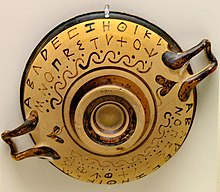Lambda
 | ||||||||||||||||||||||||||||||||||||||||||||||||
| Greek alphabet | ||||||||||||||||||||||||||||||||||||||||||||||||
|---|---|---|---|---|---|---|---|---|---|---|---|---|---|---|---|---|---|---|---|---|---|---|---|---|---|---|---|---|---|---|---|---|---|---|---|---|---|---|---|---|---|---|---|---|---|---|---|---|
| ||||||||||||||||||||||||||||||||||||||||||||||||
| History | ||||||||||||||||||||||||||||||||||||||||||||||||
| Numerals
| ||||||||||||||||||||||||||||||||||||||||||||||||
| Use in other languages | ||||||||||||||||||||||||||||||||||||||||||||||||
| Related topics | ||||||||||||||||||||||||||||||||||||||||||||||||
| ||||||||||||||||||||||||||||||||||||||||||||||||
|
Lambda (/ˈlæmdə/;[1] uppercase Λ, lowercase λ; Greek: λάμ(β)δα, lám(b)da) is the eleventh letter of the Greek alphabet, representing the voiced alveolar lateral approximant IPA: [l]. In the system of Greek numerals, lambda has a value of 30. Lambda is derived from the Phoenician Lamed. Lambda gave rise to the Latin L and the Cyrillic El (Л). The ancient grammarians and dramatists give evidence to the pronunciation as [laːbdaː] (λάβδα) in Classical Greek times.[2] In Modern Greek, the name of the letter, Λάμδα, is pronounced [ˈlam.ða].
In early Greek alphabets, the shape and orientation of lambda varied.[3] Most variants consisted of two straight strokes, one longer than the other, connected at their ends. The angle might be in the upper-left, lower-left ("Western" alphabets) or top ("Eastern" alphabets). Other variants had a vertical line with a horizontal or sloped stroke running to the right. With the general adoption of the Ionic alphabet, Greek settled on an angle at the top; the Romans put the angle at the lower-left.
The HTML 4 character entity references for the Greek capital and small letter lambda are Λ and λ respectively.[4] The Unicode code points for lambda are U+039B and U+03BB.

Symbol
Upper-case letter Λ
Examples of the symbolic use of uppercase lambda include:
- The lambda particle is a type of subatomic particle in subatomic particle physics.
- Lambda is the set of logical axioms in the axiomatic method of logical deduction in first-order logic.
- There is a poetical allusion to the use of Lambda as a shield blazon by the Spartans.[citation needed][5]
- Lambda is the von Mangoldt function in mathematical number theory.
- Lambda denotes the de Bruijn–Newman constant which is closely connected with Riemann's hypothesis.
- In statistics, lambda is used for the likelihood ratio.
- In statistics, Wilks's lambda is used in multivariate analysis of variance (MANOVA analysis) to compare group means on a combination of dependent variables.
- In the spectral decomposition of matrices, lambda indicates the diagonal matrix of the eigenvalues of the matrix.
- In computer science, lambda is the time window over which a process is observed for determining the working memory set for a digital computer's virtual memory management.
- In astrophysics, lambda represents the likelihood that a small body will encounter a planet or a dwarf planet leading to a deflection of a significant magnitude. An object with a large value of lambda is expected to have cleared its neighbourhood, satisfying the current definition of a planet.
- In crystal optics, lambda is used to represent a lattice period.
- In NATO military operations, a chevron (a heraldic symbol which looks like a capital letter lambda or inverted V) is painted on the vehicles of this military alliance for identification.
- In electrochemistry, lambda denotes the "equivalent conductance" of an electrolyte solution.
- In cosmology, lambda is the symbol for the cosmological constant, a term added to some dynamical equations to account for the accelerating expansion of the universe.
- In optics, lambda denotes the grating pitch of a Bragg reflector. Also in optics, it denotes wavelength of light.
- In politics, the lambda is the symbol of Identitarianism, a white nationalist movement that originated in France before spreading out to the rest of Europe and later on to North America, Australia and New Zealand. The Identitarian lambda represents the Battle of Thermopylae.














